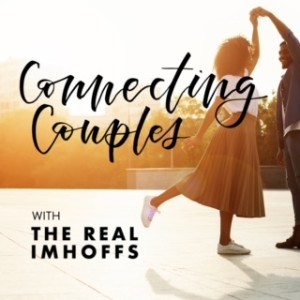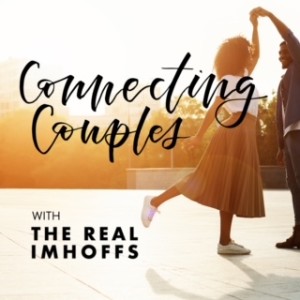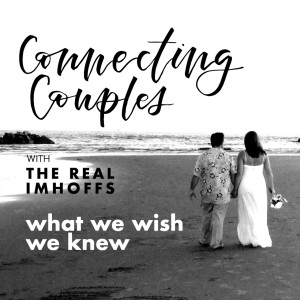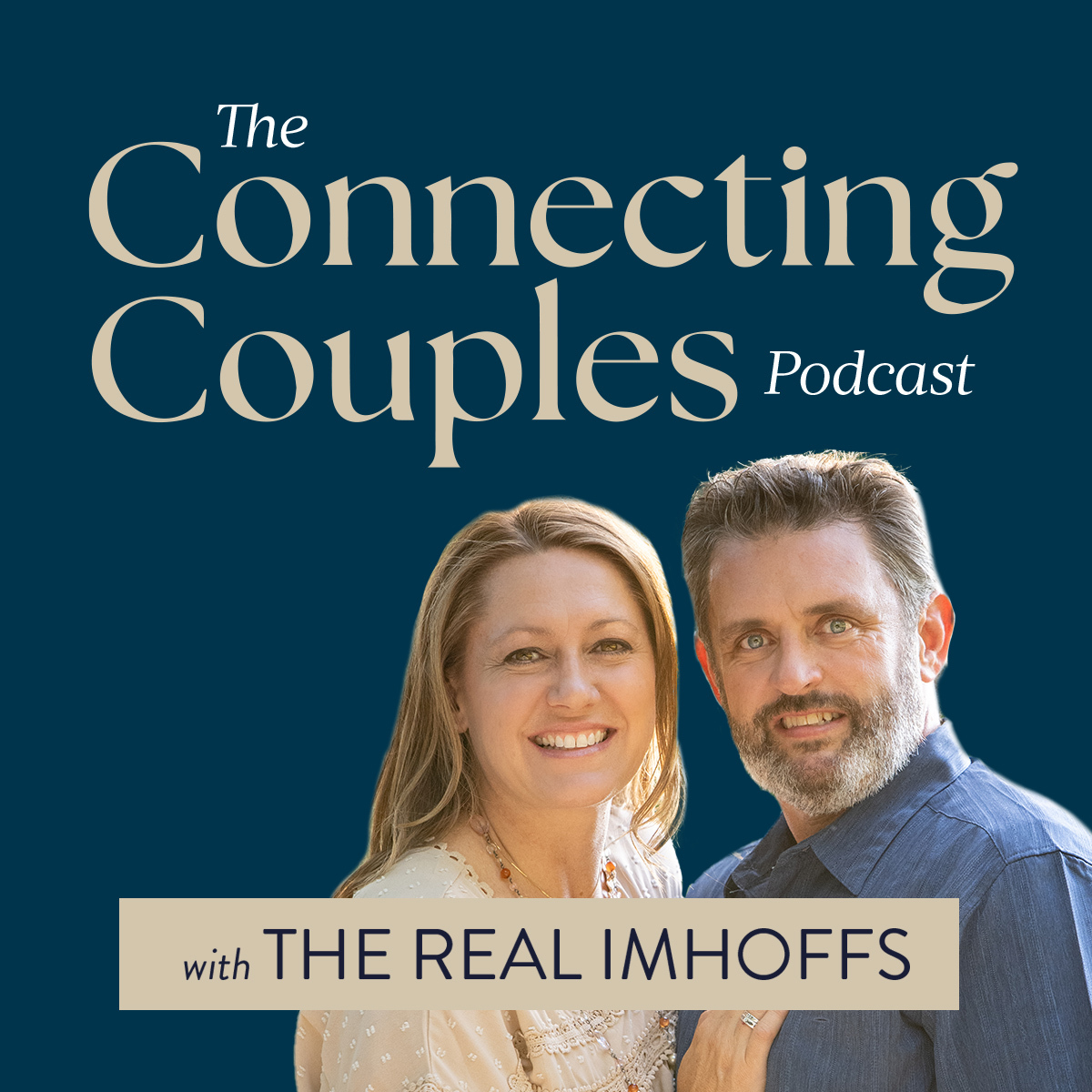
The Real Imhoffs
Chad and Angela Imhoff invite you to join them in real conversations about relationships. You'll hear validating content that normalizes interactions between partners, then you'll listen as the Imhoffs give you tools to have new conversations around familiar content. They use examples from their own relationship and give you practical and tangible options that you can apply in your relationship to feel more connected.
Dr. Chad Imhoff earned his PhD in Counselor Education from the University of Arkansas. He is a licensed Marriage and Family Therapist, a certified EFT Therapist and Supervisor and the Clinical Director at The Joshua Center, a private agency in Fayetteville, Arkansas.
Angela Imhoff earned her masters in Marriage and Family Therapy from John Brown University. She is the Ministry Leader for a faith based 12-step program at their church and she is a Certified Life Coach.
The Imhoffs often host workshops for couples and enjoy helping people find ways to feel more connected to themselves and to each other. For more information about Chad and Angela, check out their website at: www.therealimhoffs.com
Episodes

Wednesday Jun 08, 2022
Pursuers and Withdrawers: Episode 6- De-Escalated Pursuers
Wednesday Jun 08, 2022
Wednesday Jun 08, 2022
Connecting Couples Podcast: Series: Pursuers and Withdrawers
Episode 6: De-Escalated Pursuers
First 5 minutes:
Escalation happens quickly and sends us into a cycle that puts both partners into their strategies. How do we know when we are able to remain de-escalated in our cycle? De-Escalation doesn’t mean we don’t fight. It means withdrawers are more engaged and pursuers can have more awareness around what is happening for them internally. Pursuers often feel hijacked by their emotion- so quickly that its often hard to stop. When we review a Rocky Moment- can we recognize the part we played in what went wrong.
Minutes 5-10:
Healthier behaviors for a Pursuers looks like an ability to recognize what is happening inside of them emotionally during their interactions. If the focus is still on the behavior of others, the goal is to shift that focus internally into what the behavior of the other person is or is not making them feel. Could be anxious or frustrated or sadness or chaos, any emotional recognition is more aware then none.
A half step to understanding internal cues could be, ‘something is going on and I can feel it, but I don’t know what it is.” De-escalation means that you can slow your cycle down a bit and understand the other things that are at play- in TEMP, the emotion and the meaning parts.
Minutes 10-15:
A pursuer can tell their withdrawer a body marker. I would look something like- “I can feel the energy in my body ramping up and I need you to help me.” The idea of being escalated or de-escalated is a continuum. It’s not one destination or the other. It’s fluid and you can go back and forth depending on how secure you feel in your connection.
In healthier places, the partner can help the Pursuer deregulate if they are starting to feel anxious or out of control.
Minutes 15-20:
De-Escalated Pursuers don’t stop being pursuers. They are just able to slow down some of the “P” Protective Actions- the behaviors. Instead of working on managing the things around them to decrease the chaotic feelings, they can articulate to their partner what they feel and what they feel drawn to do. ‘I feel overwhelmed and I want to manage everyone.”
Slight adjustments can change the interactions from getting into a cycle to understanding each other better. Once you are in a place where you can share what is happening, you can start to create to meaning around your interactions. The goal IS NOT to just calm down or to deregulate. The goal is to connect in distress.
Minutes 20-25:
As a pursuer, a recognizable shift in emotional health is to start to see how our strategies in a cycle land on or affect our partner. We are able to return to a fight quicker and even initiate a repair owning or acknowledging the part we played in it and sharing our deeper longing or desire.
Connect Point: Imagine that you, as the Pursuer, is sharing with your partner what is going on internally or emotionally instead of focusing on the withdrawer’s behaviors or lack of behavior. How do you think that would go? If you are the withdrawer, imagine your pursuer coming to you with their internal process versus what you are or are not doing. How do you think you would respond to that? Discuss the possibility of a different interaction.
For more information about Chad and Angela, check out their website: www.therealimhoffs.com

Wednesday Jun 01, 2022
Pursuers and Withdrawers: Episode 5- The Withdrawer’s Dilemma
Wednesday Jun 01, 2022
Wednesday Jun 01, 2022
Connecting Couples Podcast: Series: Pursuers and Withdrawers
Episode 5: The Withdrawer’s Dilemma Show Notes.
First 5 minutes:
Withdrawers have a hard time receiving feedback because any feedback lands like criticism. Feedback doesn’t mean ‘opportunity’ for a withdrawer, it means they must have gotten something wrong. Withdrawers are often anticipating that someone is going to tell them they got it wrong, so they are looking for it themselves so they can anticipate where it’s going to come from.
Minutes 5-10:
Pursuers often feel like withdrawers get things wrong and withdrawers often feel like withdrawers are getting it wrong. Both strategies tend to blame the withdrawers for what is going wrong. Withdrawers are not trying to set off their pursuers. The message they get is that conflict is bad, and therefore they are trying to avoid it at all costs.
Pursuers tend to have an anxious attachment strategy, while withdrawers tend to have an avoidant attachment strategy. So the internal message of the withdrawer can be, others are better off if I am not around, and I am better off not being around… but then they lose connection. Withdrawers want and need feedback to measure themselves, but feedback is dangerous and often lands like criticism, so they are in a double bind, wanting feedback but being afraid of the message that comes with it.
Minutes 10-15:
Withdawers then often find something else to ‘go to’ or validate themselves with because they aren’t getting it from their partner. Drinking, hobbies, isolated options. Example of working on a car in the garage- being in the garage and working on the car re-enforces the message that they probably don’t know how to engage with their family.
Errors or assumption from the pursuers is that their withdrawers aren’t really thinking about the connection they want. They are, but they don’t think they will or even can succeed at it, so they choose lonely over failure.
Humor is a great strategy for a withdrawer to stay engaged but try to stay out of the distress, but when used in conflict, it might backfire.
Minutes 15-20:
Unless a person has done some emotional work, most of them, both pursuers and withdrawers, don’t even know that their strategies are hijacking them. The more a withdrawer withdraws, the more likely they are to fail at the thing they are trying to protect- the relationship.
The message the withdrawer strategy often sends is that they don’t ‘need’ connection or their partner, but they do. We all need connection. The pursuers can also see the withdraw as a sign that they aren’t safe to their partner or trusted by their partner.
Minutes 20-25:
In distress, when a withdrawer ‘goes along’ with the purser, its’ often seen as capitulating or placating. Withdrawers are not maliciously or intentionally trying to get it wrong. Even secure relationships have to work on their cycle and their process.
Connect Point: Both partners take time to discuss one of the dilemmas withdrawers face that brings up empathy or compassion for the process your withdrawer is going through.
For more information about Chad and Angela, check out their website: www.therealimhoffs.com

Wednesday May 25, 2022
Pursuers and Withdrawers: Episode 4- The Pursuer’s Dilemma
Wednesday May 25, 2022
Wednesday May 25, 2022
Connecting Couples Podcast: Series: Pursuers and Withdrawers
Episode 4: The Pursuer's Dilemma Show Notes.
First 5 minutes:
Pursuers often feel like their thought process might be too much and therefore are already modifying or holding back some of the energy they have. This episode is designed to bring up empathy for our Pursuers.
Minutes 5-10:
The first dilemma we bring up is when we see something that isn’t done the way we thought it should be. Should the pursuer only show gratitude for the effort, or should the pursuer point out what might be wrong with how it was done- which reinforces the message that no one can get it right for them.
Another dilemma is when pursuers are in an interaction and start to feel like the other person isn’t understanding them- the internal process is possibly to go bigger- make it more urgent, use more words, etc… or not saying anything, but feel like that won’t work. If pursuers show more energy to help clarify the interaction, they are seen as too much.
Minutes 10-15:
If pursuers don’t ‘take control’ of situations that feel like they are not going well, then they feel compromised- their motivation is to help all situations run the best. Pursuers can often try to use silence- still to get a response from their partners.
If pursuers don’t say anything, their anxiety builds because they feel compelled to bring attention to what is going wrong. But it takes so much energy to both hold back, but then to bring it forward. It’s a catch 22. The intent for why the pursuers fight so hard comes from such a good place in their hearts. Pursuers just want ‘everyone to do their part.’ It’s exhausting and pursuers get burnt out.
Minutes 15-20:
Pursuers can get to a sense of hopelessness when they have been doing so much for so long without help or acknowledgement. When we have to ask for, even in a demanding way, for needs to be met, pursuers then feel too needy.
The systems that pursuers have in place for everything to run well, end up running them and everyone else and if the systems start failing, a pursuers anxiety will begin to build.
Pursuers take on so much and even pick up the slack for others, but then the system learns to rely on the pursuer and possibly even just let the pursuer do it all. But then pursuers get no relief.
Minutes 20-25:
Pursuers believe (and often withdrawers will agree) that they are working harder and doing more than everyone else. And the real sad part is that pursuers also blame themselves when things start going wrong.
Pursuers are willing to try anything and everything to get the response they need.
Connect Point: Both partners take time to discuss one of the dilemmas pursuers face that brings up empathy or compassion for the process your pursuer is going through.
For more information about Chad and Angela, check out their website: www.therealimhoffs.com

Wednesday May 18, 2022
Pursuers and Withdrawers: Episode 3- Honoring Withdrawers
Wednesday May 18, 2022
Wednesday May 18, 2022
Connecting Couples Podcast: Series: Pursuers and Withdrawers
Episode 3: “Honoring Withdrawers” Show Notes.
First 5 minutes:
Withdrawers have the ability to keep emotion from getting in the way of their task. They have been learning these strategies since their developmental years and life has taught them that it is a benefit to be able to stay calm in chaos.
Withdrawers can maintain the appearance of stoicism on the outside even in the evidence of stress. Withdrawers do research and like to know that the decision they are making is the best one.
Minutes 5-10:
The way a withdrawer nurtures a relationship is to be diligent about being accurate. They spend a lot of time thinking through what the best choice or best answer would be. Withdrawers are stoic and pursuers lean on their stability in times of distress.
Withdrawers look into danger or distress and can maintain composure to try and restore things to stable again. Withdrawers have an internal check list that helps them stay focused amidst distraction.
Minutes 10-15:
While Pursers like systems- they tend to be external systems that they need others to follow. Withdrawers run on internal systems for themselves to remain stable in all circumstances. Withdrawers are trying really hard NOT to fail, even to the fault of it being methodical.
Withdrawers are pretty self-reliant and we often see their self-reliance as low maintenance, but that also means we can miss their heart. Often if we ‘check in’ on a withdrawer, they can feel like they got it wrong- just because we are drawing attention to their possible need. Withdrawers want to make sure they look ‘ok’ even if they are not.
Minutes 15-20:
Withdrawers are like health and safety; they just want to keep everything ‘good enough’. Withdrawers are the pace cars for those around them. While pursuers tend to want to pick up the pace or continually look for ways to improve, withdrawers appreciate it when things are stable and there is nothing on fire.
Minutes 20-25:
Withdrawers know how to use humor to lighten the mood or help absorb some of the tension. They know how to ‘de-escalate’ the tension in the room with humor or by distracting or changing the subject. Withdrawers having a willingness to ‘go along’ with the Pursuers plans or systems without much push back, even if they have a more accurate way.
Connect Point: Both partners honor one good thing about the withdrawer in their relationship.
For more information about Chad and Angela, check out their website: www.therealimhoffs.com

Wednesday May 11, 2022
Pursuers and Withdrawers: Episode 2- Honoring Pursuers
Wednesday May 11, 2022
Wednesday May 11, 2022
Connecting Couples Podcast: Series: Pursuers and Withdrawers
Episode 2: “Honoring Pursuers” Show Notes.
First 5 minutes:
Pursuers are really working hard to stay connected and to help the relationship stay connected.
Pursuers are HOPEFULL. They believe that the efforts they are contributing are really going to work! Pursuers are RESOURCEFUL.
They are going to try everything possibly to help the relationship thrive.
Pursers are Resilient and Creative. They have a lot of words and try hard to be clear or are very willing to clarify if you ask them for more understanding. Pursuers will take a risk to share what they are feeling and thinking if they feel there is a chance it will help.
Minutes 5-10:
Pursuers notice the problems and call them out with the intent that it will help their partner know what needs to be fixed. Pursers what things to run efficiently so a pursuers body will help them hone out what might slow down efficiency. The motivation of a purser is to do whatever is needed to help the relationship go well. Pursuers manage all the details.
Pursuers are making efforts for connection. They might not always be able to articulate that they ‘need’ their withdrawers, but the deep motivation is to connect. Pursuers discern disconnection and threat because they want to get out ahead of it.
Minutes 10-15:
Pursuers not only notice what might be going wrong, they take the risk to bring attention to it so that it can get addressed and the connection can be restored. Pursers are cheerleaders for people around them. The see everyone’s ‘potential’ and want to help them reach it. Pursuers want to share the insight they see about those around them and are pushing for everyone to be their best.
Pursers really are fighting hard for themselves, for their relationship, for their partners, for their families etc…. They are hoping for and seeking out feedback so that they can improve themselves. From books, from others, from a therapist, from a workshop. They are looking to improve themselves as well as those around them.
Connect Point: Both partners honor one good thing about the pursuer in their relationship.
For more information about Chad and Angela, check out their website: www.therealimhoffs.com

Wednesday May 04, 2022
Pursuers and Withdrawers: Episode 1- What Growth Looks Like
Wednesday May 04, 2022
Wednesday May 04, 2022
Connecting Couples Podcast: Series: Pursuers and Withdrawers
Episode 1 Show Notes. We're back from our 6-month hiatus.
First 5 minutes:
A deeper dive into both roles in the relationship cycle. Understanding more the Pursuers and the Withdrawers; their motivations, the things we love, the things that are challenging, what the strategies look like in ‘escalation’ and ‘de-escalation’.
How does this content impact your relationship (what growth will look like).
Minutes 5-10:
In process- pursuers tend to share as they go and withdrawers tend to want to have it built before they share it. Can (either strategy) recognize their own process and let your partner know about it.
The goal is NOT that you switch roles- that pursuers would become withdrawers or withdrawers would become pursuers. A healthy goal is possibly that pursuers can understand their part and share their internal process more and that Withdrawers can understand their part and let their partner in on it more.
Escalation- when the relationship is under distress and one or both partners feel heightened emotion and strategies are quickly in play. Your body is sending you strategic messages based on how you are reading or assessing the interaction. Messages might be: I’m going to be left (abandoned) as a pursuer, or I’m going to be ‘in trouble’ and I’ll shut down as a withdrawer.
Minutes 10-15:
Before understating strategies and attachment (or EARLY into your understanding of the Pursuer and Withdrawer strategies) ... you know you and your partner don’t ‘communicate’ affectively and you get into fights that don’t feel resolved. Pursuers have a tendency to increase energy and can blame their partner. Withdrawers have a tendency to shut down and often take the blame on themselves.
Couples who ‘don’t fight’ aren’t necessarily de-escalated. Not fighting might be a strategy that reduces conflict, but doesn’t always make us feel securely connected, or seen and heard.
De-escalation. Does NOT mean you will not fight. It means we can understand more what is happening, repair more, and are able to ask for our needs to get met in a way that our partner understands.
Statistic- couples often stay in distress for up to 7 years before asking for help from a therapist.
Once you get help, how can you tell if the help is making a difference. What will it look like when a couple is in a more secure place that is less escalated and more aware.
Minutes 15-end:
If you can have a conversation with your partner about what your emotional experience is (instead of discussing the content or jumping to strategy), it really starts to shift your relationship.
Growth that happens- now that I have awareness, there is a better chance for a good repair. My growth is reflected by my ability to return to a fight with the part I played and what my experience was (self-focused on own behavior and own motivations versus partners).
Connect Point: First identify (or remind yourself and your partner) what strategy you lean to in distress. Are you a Pursuer or a Withdrawer? Then, identify one or two of the moves you most likely go to and share YOUR typical moves with your partner. Let your partner share their own moves with you.
For more information about Chad and Angela, check out their website: www.therealimhoffs.com

Wednesday Sep 15, 2021
What We Wish We Knew: Episode 11- Doing The Work
Wednesday Sep 15, 2021
Wednesday Sep 15, 2021
Before wrapping this series up, Chad and Angela get really practical about a vital part of staying connected, and that is doing forgiveness work often. Its easy to say that we should not harbor offense against our partner, but when they have and sometimes continue to offend us, its easier said than done. Chad and Angela give you tangible examples of how they offend each other on a daily basis, and then show you the work they do to repair and keep their attachment secured. This is the 'work' of relationship, and without it, it is easy to get to a place where you start to believe negative things about the character of your partner. Do the work with them in this episode!
To read more about The Real Imhoffs, check out: www.therealimhoffs.com

Thursday Sep 09, 2021
What We Wish We Knew: Episode 10- This Is Hard
Thursday Sep 09, 2021
Thursday Sep 09, 2021
With just a few more episodes in this series, Chad and Angela reiterate how hard this process is. The patterns and strategies we have been leaning on for years don't just go away because we are listing to new ideas. Adapting our responses and learning how to bring a vulnerable feeling forward is a process that takes time and repetition to get good at. In this episode, the Real Imhoffs remind us that THIS IS HARD. These moves are hard. Adjusting is hard. Stopping cycles in the moment is hard. It is all hard to do... but it IS possible, which is why they encourage you to keep doing the work. In this Connect Point they have your remind your partner that you are committed to this relationship and committed to trying new things. Check it out.
For more information about Chad and Angela, check out: www.therealimhoffs.com

